POKEGB: a gameboy emulator that only plays Pokémon blue
POKEGB: A gameboy emulator that only plays Pokémon Blue
I recently tweeted out an emulator that I made over the last few days:
POKEGB: A gameboy emulator that only plays Pokémon Blue, in 62 lines of c++.
— Ben Smith (@binjimint) May 28, 2021
source: https://t.co/AGt7RUTr9H pic.twitter.com/o0BUUmzNOt
In the video, I show some source code that looks like 3 pokéballs, compile it with gcc, and run it to play Pokémon Blue. The game is controllable, but has no sound. It renders the graphics w/ 12 colors (shades of red and blue). I choose BLUE as the name for our hero, and JERK as the name of his rival. The video ends when Professor Oak stops me from walking into the tall grass.
A lot of folks asked me to do a write-up of how this all works, so let's dive in!
(TL;DR: this is a very long writeup, check out the unobfuscated code instead if you prefer!)
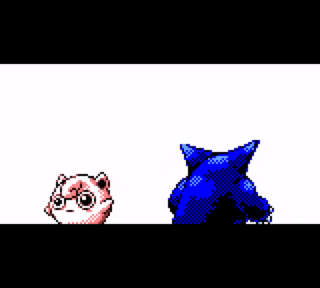
Stats
But first, let's talk a little about some statistics. The final version in that tweet is actually 68 lines of code (I tweeted the wrong number!), each line less than 150 characters long, for a total of 9956 bytes. If you ignore whitespace and comments, it comes to 4720 bytes. That's too large for the International Obfuscated C Code Contest, but pretty close.
Prior to formatting the source code to look like pokéballs, the source was 188 lines and a total of 7786 bytes, with 5954 bytes of non-whitespace source.
Overview
It'll be useful to know a little about how the gameboy works. This won't go
into all the details (for that you can read the pandocs or perhaps watch The Ultimate Gameboy Talk), but will
be enough to understand how this code works. Many values are easier to
represent in hexadecimal, so I'll write those with a leading $, e.g. $FE00.

CPU
The gameboy CPU is a bit weird — it's kind of like an Intel 8080
and kind of like a Zilog Z80, but not the same as either. It has an
8-bit accumulator A, and three 16-bit register pairs, BC, DE, and HL,
which can be individually accessed as the 8-bit registers B, C, D, E,
H and L. It also has a 16-bit stack pointer SP, a 16-bit program counter
PC.
| 16-bit | High byte | Low byte | Description |
|---|---|---|---|
| AF | A | - | Accumulator and flags |
| BC | B | C | General purpose |
| DE | D | E | General purpose |
| HL | H | L | General purpose / memory access |
| PC | - | - | Program counter |
| SP | - | - | Stack pointer |
The cpu also has 4 flag bits: Z, N, H, and C:
| Flag | Name | Description |
|---|---|---|
| Z | Zero flag | Set when the result is zero |
| N | Subtraction flag | Set if the last instruction was subtract, used for BCD |
| H | Half-carry flag | Set if there is an overflow out of bit 3, used for BCD |
| C | Carry flag | Set if there is an overflow out of bit 7 |
When accessing the AF register (which can only be done via push/pop instructions), the flags are stored in the most-significant bits of F:
| 15 | 14 | 13 | 12 | 11 | 10 | 9 | 8 | 7 | 6 | 5 | 4 | 3 | 2 | 1 | 0 |
|---|---|---|---|---|---|---|---|---|---|---|---|---|---|---|---|
| A | A | A | A | A | A | A | A | Z | N | H | C | 0 | 0 | 0 | 0 |
The gameboy instruction set has ~500 instructions, each up to 3 bytes long. For
example, the NOP instruction is just one byte (00), but the JP
instruction is 3 bytes: $C3 followed by a 16-bit address $50 $01.
The instructions can be grouped as follows (taken from peach.bot's excellent document on the Emulation Development discord). I've included all instructions, but have struck through the ones that are not needed for Pokémon Blue. Feel free to skip over this on first read, I'll go into more detail later:
| 7 | 6 | 5 | 4 | 3 | 2 | 1 | 0 | Mnemonic | ||||||
|---|---|---|---|---|---|---|---|---|---|---|---|---|---|---|
| 0 | 0 | 0 | 0 | 0 | 0 | 0 | 0 | NOP | ||||||
| 0 | 0 | 0 | 0 | 1 | 0 | 0 | 0 | |||||||
| 0 | 0 | 0 | 1 | 0 | 0 | 0 | 0 | |||||||
| 0 | 0 | 0 | 1 | 1 | 0 | 0 | 0 | JR | ||||||
| 0 | 0 | 1 | condition | 0 | 0 | 0 | JR condition | |||||||
| 0 | 0 | r16 (group 1) | 0 | 0 | 0 | 1 | LD r16, u16 | |||||||
| 0 | 0 | r16 (group 2) | 0 | 0 | 1 | 0 | LD (r16), A | |||||||
| 0 | 0 | r16 (group 1) | 0 | 0 | 1 | 1 | INC r16 | |||||||
| 0 | 0 | r16 (group 1) | 1 | 0 | 0 | 1 | ADD HL, r16 | |||||||
| 0 | 0 | r16 (group 2) | 1 | 0 | 1 | 0 | LD A, (r16) | |||||||
| 0 | 0 | r16 (group 1) | 1 | 0 | 1 | 1 | DEC r16 | |||||||
| 0 | 0 | r8 | 1 | 0 | 0 | INC r8 | ||||||||
| 0 | 0 | r8 | 1 | 0 | 1 | DEC r8 | ||||||||
| 0 | 0 | r8 | 1 | 1 | 0 | LD r8, u8 | ||||||||
| 0 | 0 | opcode (group 1) | 1 | 1 | 1 | Opcode Group 1 | ||||||||
| 0 | 1 | 1 | 1 | 0 | 1 | 1 | 0 | HALT | ||||||
| 0 | 1 | r8 (destination) | r8 (source) | LD r8, r8 | ||||||||||
| 1 | 0 | opcode (group 2) | r8 (operand 2) | ALU A, r8 | ||||||||||
| 1 | 1 | 0 | condition | 0 | 0 | 0 | RET condition | |||||||
| 1 | 1 | 0 | condition | 0 | 1 | 0 | JP condition | |||||||
| 1 | 1 | 0 | condition | 1 | 0 | 0 | CALL condition | |||||||
| 1 | 1 | 0 | 0 | 1 | 1 | 0 | 1 | CALL u16 | ||||||
| 1 | 1 | 1 | 0 | 0 | 0 | 0 | 0 | LD ($FF00 + u8), A | ||||||
| 1 | 1 | 1 | 0 | 0 | 0 | 1 | 0 | LD ($FF00 + C), A | ||||||
| 1 | 1 | 1 | 0 | 1 | 0 | 0 | 0 | |||||||
| 1 | 1 | 1 | 0 | 1 | 0 | 1 | 0 | LD (u16), A | ||||||
| 1 | 1 | 1 | 1 | 0 | 0 | 0 | 0 | LD A, ($FF00 + u8) | ||||||
| 1 | 1 | 1 | 1 | 0 | 0 | 1 | 0 | |||||||
| 1 | 1 | 1 | 1 | 1 | 0 | 0 | 0 | LD HL, SP + i8 | ||||||
| 1 | 1 | 1 | 1 | 1 | 0 | 1 | 0 | LD A, (u16) | ||||||
| 1 | 1 | r16 (group 3) | 0 | 0 | 0 | 1 | POP r16 | |||||||
| 1 | 1 | opcode (group 4) | 0 | 1 | 1 | Opcode group 4 | ||||||||
| 1 | 1 | r16 (group 3) | 0 | 1 | 0 | 1 | PUSH r16 | |||||||
| 1 | 1 | opcode (group 2) | 1 | 1 | 0 | ALU A, u8 | ||||||||
| 1 | 1 | EXP | 1 | 1 | 1 | |||||||||
You can also use the CB prefix to access a different set of instructions:
| 7 | 6 | 5 | 4 | 3 | 2 | 1 | 0 | Mnemonic | ||||||
|---|---|---|---|---|---|---|---|---|---|---|---|---|---|---|
| 0 | 0 | opcode (group 3) | r8 | Shift/Rotate | ||||||||||
| 0 | 1 | bit | r8 (source) | BIT bit, r8 | ||||||||||
| 1 | 0 | bit | r8 (source/dest) | RES bit, r8 | ||||||||||
| 1 | 1 | bit | r8 (source/dest) | SET bit, r8 | ||||||||||
r8 is encoded as:
| value | register |
|---|---|
| 0 | B |
| 1 | C |
| 2 | D |
| 3 | E |
| 4 | H |
| 5 | L |
| 6 | (HL) |
| 7 | A |
r16 is encoded as:
| value | group 1 | group 2 | group 3 |
|---|---|---|---|
| 0 | BC | BC | BC |
| 1 | DE | DE | DE |
| 2 | HL | HL+ | HL |
| 3 | SP | HL- | AF |
condition is encoded as:
| value | condition | Meaning |
|---|---|---|
| 0 | NZ | Zero flag is 0 |
| 1 | Z | Zero flag is 1 |
| 2 | NC | Carry flag is 0 |
| 3 | C | Carry flag is 1 |
opcode is encoded as:
| value | group 1 | group 2 | group 3 | group 4 |
|---|---|---|---|---|
| 0 | RLCA | ADD | RLC | JP |
| 1 | RRCA | ADC | RRC | CB prefix |
| 2 | RLA | SUB | RL | illegal |
| 3 | SBC | RR | illegal | |
| 4 | DAA | AND | SLA | illegal |
| 5 | CPL | XOR | SRA | illegal |
| 6 | SCF | OR | SWAP | DI |
| 7 | CCF | CP | SRL | EI |
As you can see, there are many instructions but we can group them into ~40
different categories, 5 of which aren't used by Pokémon Blue (as far as I
know). (Turns out I was wrong, RRA is used; see the TryingToLearn function
in the pokered source).
One additional complication is how long each of these instructions take to execute. This is measured in "T-states", which run at the frequency of the CPU, ~4.19MHz. All instructions operate on a multiple of 4 T-states, which is often called machine-cycles or "M-cycles".
It's important to keep track of how many M-cycles each instruction takes, since other hardware components (such as the graphics rendering and audio) take time too, and we want to make sure that the CPU and these components stay in sync. Fortunately, the M-cycle counts for most instructions is relatively simple — every memory access costs 1 M-cycle (including the cost of reading the instruction). Some instructions take additional M-cycles, but we can handle those cases explicitly.
Memory
The gameboy CPU has a 16-bit address space, divided up into regions with different purposes. Here's a simplified layout:
| Low | High | Size (in bytes) | Purpose |
|---|---|---|---|
| $0000 | $3FFF | 16384 | Cartridge ROM bank 0 |
| $4000 | $7FFF | 16384 | Cartridge ROM bank 1 |
| $8000 | $9FFF | 8192 | Video RAM |
| $A000 | $BFFF | 8192 | External RAM (often battery-backed) |
| $C000 | $DFFF | 8192 | Work RAM |
| $E000 | $FDFF | 7680 | Mirror of C000-DEFF |
| $FE00 | $FE9F | 160 | Object attribute memory (OAM) |
| $FEA0 | $FEFF | 96 | Unused |
| $FF00 | $FF7F | 128 | Memory-mapped I/O |
| $FF80 | $FFFF | 128 | "High" RAM |
Memory Bank Controllers
Gameboy cartridges often also use a Memory Bank Controller (MBC), which allows swapping out regions of ROM and RAM at runtime, as well as other features. Without this it would be impossible to access more than 32768 bytes of ROM.
Pokémon Blue uses MBC3, which has the ability to swap 64 different 16KiB banks of ROM (for a total of 1MiB), as well as 4 different of 8KiB banks of External Ram (for a total of 32KiB). The Pokémon Blue cartridge also has support for a real-time clock, but I didn't implement support for that.
The way you communicate with the MBC is by writing to various address regions
in ROM (i.e. in the range $0000-$7FFF). See the following table for details.
The features that are unimplemented in pokegb have been struck through:
| Low | High | Purpose |
|---|---|---|
| $0000 | $1FFF | |
| $2000 | $3FFF | ROM bank number |
| $4000 | $5FFF | RAM bank number |
| $6000 | $7FFF |
Reading and writing to external RAM can be enabled and disabled. I believe this was used because the CPU may write garbage data to memory when losing power (e.g. when the gameboy is switched off). We don't care about that, so we'll skip implementing it. Fortunately, as far as I can tell, the game doesn't ever read from or write to this region when it is disabled.
As mentioned before, the cartridge is 1MiB, but the CPU address space is only 64KiB. So to access the rest of the cartridge data we have to remap ROM. Only ROM bank 1 can be remapped; ROM bank 0 is always mapped to the cartridge's first 16KiB chunk.
The mapped memory region in ROM bank 1 can be changed by writing a value
between 0 and 63 to any address in the region $2000-$3FFF. So for example, if
we write the value 5 to address $2000, then the data mapped to addresses
$4000-$7FFF will reference the sixth 16KiB ROM bank of the cartridge (which
are the bytes in range $14000-$17FFF). The one exception is that if bank 0 is
selected, then the cartridge's second ROM bank is selected instead of the
first.
Similarly, the external RAM address space is only 8KiB, but the available RAM
is 32KiB. Writing a value between 0 and 3 to $4000-$5FFF will select a RAM
bank.
Memory-mapped I/O
The gameboy has 128 bytes of memory-mapped I/O, from address $FF00 to
$FF7F. These addresses are sometimes called registers, not to be confused
with the CPU registers. Not all of these addresses are used by the gameboy, and
not all of the valid addresses are used by Pokémon Blue, and not all of the
addresses used by Pokémon Blue are implemented in pokegb!
Here is a list of the registers used by the original gameboy, with the unimplemented ones struck through:
| Low | High | Name | Description |
|---|---|---|---|
| $FF00 | $FF00 | JOYP | Joypad input |
| $FF01 | $FF02 | SB / SC | |
| $FF04 | $FF04 | DIV | Clock divider |
| $FF05 | $FF07 | TIMA / TMA / TAC | |
| $FF0F | $FF0F | IF | Interrupt request |
| $FF10 | $FF3F | - | |
| $FF40 | $FF40 | LCDC | LCD control |
| $FF41 | $FF41 | STAT | |
| $FF42 | $FF43 | SCY / SCX | Background scroll registers |
| $FF44 | $FF44 | LY | Current Y line being drawn |
| $FF45 | $FF45 | LYC | |
| $FF46 | $FF46 | DMA | DMA transfer to OAM |
| $FF47 | $FF47 | BGP | Background palette |
| $FF48 | $FF49 | OBP0 / OBP1 | Object palettes |
| $FF4A | $FF4B | WY / WX | Window location |
| $FFFF | $FFFF | IE | Interrupt enable |
Unfortunately, sound is completely skipped in pokegb. It would be fun to have, but would require a lot more code, I think.
Several of the registers are used as full 8-bit values (DIV, SCY, SCX,
LY, WY, WX). Others give meaning to individual bits:
| Register | 7 | 6 | 5 | 4 | 3 | 2 | 1 | 0 | ||||||||
|---|---|---|---|---|---|---|---|---|---|---|---|---|---|---|---|---|
| JOYP | 1 | 1 | 1 | 1 | 1 | 1 | 1 | 1 | ||||||||
| JOYP (reading directions) | 1 | 1 | 1 | 0 | ~Down | ~Up | ~Left | ~Right | ||||||||
| JOYP (reading buttons) | 1 | 1 | 0 | 1 | ~Start | ~Select | ~B | ~A | ||||||||
| LCDC | LCD enable | Window tile map | Window enable | BG/Window tile data | BG tile map | Object enable | ||||||||||
| IF | 1 | 1 | 1 | Vblank | ||||||||||||
| IE | 1 | 1 | 1 | Vblank | ||||||||||||
| BGP | color 3 | color 2 | color 1 | color 0 | ||||||||||||
| OBP0 | color 3 | color 2 | color 1 | color 0 | ||||||||||||
| OBP1 | color 3 | color 2 | color 1 | color 0 | ||||||||||||
As can be seen from the table, reading from the joypad gives different values
depending on whether bits 4 or 5 of JOYP are 0. Typically the program will
write to JOYP to read the directions and buttons separately, then later combine
them into one byte. Also, the buttons are labeled with a leading ~ because they
are inverted; e.g. the up direction is pressed when bit 2 is 0.
LCDC has a few bits to enable/disable the various rendering layers:
background, window and objects (i.e. sprites). It also has some bits to choose
which region of video RAM is used for map and tile data:
| Bit | 0 | 1 |
|---|---|---|
| Window tile map | $9800-$9BFF | $9C00-$9FFF |
| BG/Window tile data | $8800-$97FF | $8000-$8FFF |
| BG tile map | $9800-$9BFF | $9C00-$9FFF |
The IF and IE request and enable various interrupt sources, respectively.
If a given interrupt is requested and enabled, and the Interrupt Master Enable
flag (IME) is enabled, then an interrupt is fired. This will cause the CPU to
stop normal execution and jump to an address for the "interrupt handler", the
code that will respond to the interrupt, then return control back to the main
program. Of all of the possible sources, pokegb only supports the vblank
interrupt. The timer and serial interrupts are also used by Pokémon Blue, but
are not implemented.
Finally, the BGP, OBP0, and OBP1 registers pick a palette color for the
background and sprites. When rendering graphics, the gameboy can pick from 4
color values, each of which is an index into the appropriate palette. The
palette then chooses what those color values mean:
| Value | Color |
|---|---|
| 0 | White |
| 1 | Light gray |
| 2 | Dark gray |
| 3 | Black |
For pokegb, I decided to use a more fun palette with different colors for BGP, OBP0, and OBP1.
Graphics
The gameboy has a 160x144 pixel LCD screen. The graphics hardware (also known as a Picture Processing Unit or PPU) has the ability to draw one 32x32 scrollable background layer, one 32x32 "window" layer, and up to 40 8x8- or 8x16-pixel sprites. It has 8192 bytes of video RAM to stores the tile and map data. Each tile stores the pixel colors for an 8x8 block. The gameboy only has 4 colors, so each pixel's color can be represented with only 2 bits, or 4 pixels per byte. As a result, each tile is 16 bytes. The map is an array of 32x32 indexes into the tile data, one byte per tile. So the 32x32 background and window maps each use 1024 bytes.
It turns out that Pokémon Blue uses the background, window and sprite layers, but only uses 8x8-pixel sprites.
As shown above, the address of the BG and window maps can be chosen to be
either $9800-$9BFF or $9C00-$9FFF. Similarly the BG/Window tile data region
can be chosen to be either $8000-$8FFF or $8800-$97FF. Interestingly, if
$8800-$97FF is selected the tile indexes start at $9000 and wrap around.
So, for example, tile index 127 is at address $97F0 and tile index 255 is at
address $8FF0.
The way the gameboy actually renders the screen is fairly complex (see Pixel FIFO in pandocs), but we can cheat. Most games (including Pokémon Blue) don't change any graphics settings while a scanline is drawing. So we can draw each scanline as it finishes.
Each scanline takes 456 T-states (or 114 M-Cycles) to render. The current
T-state for this scanline is sometimes called a "dot", which has a value
in the range 0-455. There are a total of 144 scanlines, and 10 lines of
"vertical blank" for a total of 154 lines per screen. So the amount of time it
takes to render a full screen is 70224 T-states (or 17556 M-cycles).
The vertical blank (or vblank) scanlines are a holdover from CRT screens, which needed this period to reset the electron gun to the upper-left corner of the screen. This happens to be a useful feature for the gameboy too, even though it uses an LCD screen instead, since it is a period when the PPU is not accessing video RAM or other video hardware. This gives the software an opportunity to update video RAM without affecting the on-screen visuals.
Window
The window layer is a region displayed over the background layer. It can be
enabled or disabled, and positioned with the WX and WY registers. When it
is enabled, it always starts at the location (WX, WY - 7) and covers the
background in a rectangular region toward the lower-right of the screen. It is
not scrolled by the SCX and SCY registers.
The window is used in Pokémon Blue to display the title credits, various animations, menus, etc.
Sprites
The gameboy hardware supports up to 40 sprites per frame, and up to 10 sprites per scanline. Each sprite is defined in the OAM and uses 4 bytes. The bytes are laid out as follows:
| Byte | 7 | 6 | 5 | 4 | 3 | 2 | 1 | 0 | ||||||||
|---|---|---|---|---|---|---|---|---|---|---|---|---|---|---|---|---|
| 0 | Y-coordinate - 16 | |||||||||||||||
| 1 | X-coordinate - 8 | |||||||||||||||
| 2 | Tile index | |||||||||||||||
| 3 | Priority | Y-flip | X-flip | Palette | 0 | 0 | 0 | 0 | ||||||||
The x- and y-coordinates of the sprite is offset by 8 and 16 pixels, respectively. This is done so a sprite can be displayed off the left or top edge of the screen. The sprite will be displayed if the x-coordinate is in the range 0-167 and the y-coordinate is in the range 0-161, inclusive.
Unlike the BG/Window, the sprite tile data is always at $8000-$8FFF, but
otherwise the tile data is displayed the same way.
The priority bit specifies whether this sprite is displayed in front of (0) or behind (1) the background/window. You can see this effect in Pokémon Blue when your player walks in the tall grass. It works because the Background color 0 is considered to be transparent, so the sprite will display through.
The x-flip and y-flip bits will flip the displayed sprite horizontally, vertically, or both, but otherwise will not affect how the sprite is displayed.
The palette bit specifies whether to use OBP0 or OBP1 when displaying the
sprite.
Tiles
The background layer, window layer and sprite layer are all made up of 8x8 tiles. Each tile is 16 bytes, using 2 bits-per-pixel. For each pixel, there is a low bit and a high bit. The low bit and high bits are stored in separate bytes, where each byte stores one row:
| Offset | Row | Bit |
|---|---|---|
| 0 | Row 0 | Low bit |
| 1 | Row 0 | High bit |
| 2 | Row 1 | Low bit |
| 3 | Row 1 | High bit |
| 4 | Row 2 | Low bit |
| 5 | Row 2 | High bit |
| 6 | Row 3 | Low bit |
| 7 | Row 3 | High bit |
| 8 | Row 4 | Low bit |
| 9 | Row 4 | High bit |
| 10 | Row 5 | Low bit |
| 11 | Row 5 | High bit |
| 12 | Row 6 | Low bit |
| 13 | Row 6 | High bit |
| 14 | Row 7 | Low bit |
| 15 | Row 7 | High bit |
So for example, if we wanted to draw the pokéball that Ash is tossing on the title screen:
| Row | 7 | 6 | 5 | 4 | 3 | 2 | 1 | 0 | ||||||||
|---|---|---|---|---|---|---|---|---|---|---|---|---|---|---|---|---|
| 1 | 0 | 0 | 0 | 3 | 3 | 3 | 0 | 0 | ||||||||
| 2 | 0 | 0 | 3 | 2 | 1 | 0 | 3 | 0 | ||||||||
| 3 | 0 | 3 | 2 | 2 | 1 | 1 | 2 | 3 | ||||||||
| 4 | 0 | 3 | 2 | 2 | 2 | 2 | 2 | 3 | ||||||||
| 5 | 0 | 2 | 1 | 2 | 2 | 2 | 0 | 3 | ||||||||
| 6 | 0 | 0 | 3 | 0 | 0 | 0 | 3 | 0 | ||||||||
| 7 | 0 | 0 | 0 | 2 | 3 | 3 | 0 | 0 | ||||||||
| 8 | 0 | 0 | 0 | 0 | 0 | 0 | 0 | 0 |
Then we would separate the tile into two bit planes, where the low bit plane only has the values 0 or 1, and the high bit plane only has the values 0 or 2. If we add them together for each pixel, we'll get the image above:
| Row | Low byte | 7 | 6 | 5 | 4 | 3 | 2 | 1 | 0 | High byte | 7 | 6 | 5 | 4 | 3 | 2 | 1 | 0 | |||||||||||||||||
|---|---|---|---|---|---|---|---|---|---|---|---|---|---|---|---|---|---|---|---|---|---|---|---|---|---|---|---|---|---|---|---|---|---|---|---|
| 1 | $1C | 0 | 0 | 0 | 1 | 1 | 1 | 0 | 0 | $1C | 0 | 0 | 0 | 2 | 2 | 2 | 0 | 0 | |||||||||||||||||
| 2 | $2A | 0 | 0 | 1 | 0 | 1 | 0 | 1 | 0 | $32 | 0 | 0 | 2 | 2 | 0 | 0 | 2 | 0 | |||||||||||||||||
| 3 | $4D | 0 | 1 | 0 | 0 | 1 | 1 | 0 | 1 | $73 | 0 | 2 | 2 | 2 | 0 | 0 | 2 | 2 | |||||||||||||||||
| 4 | $41 | 0 | 1 | 0 | 0 | 0 | 0 | 0 | 1 | $7F | 0 | 2 | 2 | 2 | 2 | 2 | 2 | 2 | |||||||||||||||||
| 5 | $21 | 0 | 0 | 1 | 0 | 0 | 0 | 0 | 1 | $5D | 0 | 2 | 0 | 2 | 2 | 2 | 0 | 2 | |||||||||||||||||
| 6 | $22 | 0 | 0 | 1 | 0 | 0 | 0 | 1 | 0 | $22 | 0 | 0 | 2 | 0 | 0 | 0 | 2 | 0 | |||||||||||||||||
| 7 | $0C | 0 | 0 | 0 | 0 | 1 | 1 | 0 | 0 | $1C | 0 | 0 | 0 | 2 | 2 | 2 | 0 | 0 | |||||||||||||||||
| 8 | $00 | 0 | 0 | 0 | 0 | 0 | 0 | 0 | 0 | $00 | 0 | 0 | 0 | 0 | 0 | 0 | 0 | 0 |
We then interleave these bit planes as shown above to get the 16 bytes for this tile:
$1C $1C $2A $32 $4D $73 $41 $7F $21 $5D $22 $22 $0C $1C $00 $00
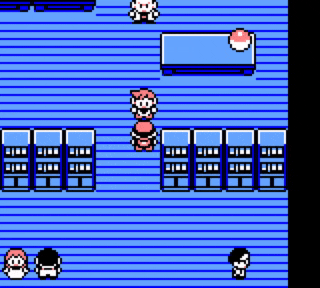
Making Pokegb
With that out of the way, I'd like to talk a little about how I made pokegb. I started working on Monday, May 24th. I've already written a gameboy emulator (binjgb), so I knew some of what I'd have to do. But I didn't know a lot about Pokémon Blue's code. The gameboy actually has a lot of features, and I didn't know how many Pokémon Blue used. I was hoping that I could avoid implementing a lot of them to keep the code small.
I decided to start by loading the game in binjgb and tracing the instructions. The trace output looked like this:
A:01 F:Z-HC BC:0013 DE:00d8 HL:014d SP:fffe PC:0100 (cy: 0) ppu:+0 |[00]0x0100: 00 nop
A:01 F:Z-HC BC:0013 DE:00d8 HL:014d SP:fffe PC:0101 (cy: 4) ppu:+0 |[00]0x0101: c3 50 01 jp $0150
A:01 F:Z-HC BC:0013 DE:00d8 HL:014d SP:fffe PC:0150 (cy: 20) ppu:+0 |[00]0x0150: fe 11 cp a,17
A:01 F:-N-C BC:0013 DE:00d8 HL:014d SP:fffe PC:0152 (cy: 28) ppu:+0 |[00]0x0152: 28 03 jr z,+3
A:01 F:-N-C BC:0013 DE:00d8 HL:014d SP:fffe PC:0154 (cy: 36) ppu:+0 |[00]0x0154: af xor a,a
A:00 F:Z--- BC:0013 DE:00d8 HL:014d SP:fffe PC:0155 (cy: 40) ppu:+0 |[00]0x0155: 18 02 jr +2
A:00 F:Z--- BC:0013 DE:00d8 HL:014d SP:fffe PC:0159 (cy: 52) ppu:+0 |[00]0x0159: ea 1a cf ld [$cf1a],a
A:00 F:Z--- BC:0013 DE:00d8 HL:014d SP:fffe PC:015c (cy: 68) ppu:+0 |[00]0x015c: c3 54 1f jp $1f54
...
This prints out the CPU state after each instruction, along with a disassembly.
When I started pokegb, I spent most of the first few days implementing the CPU. Every time I hit an instruction that wasn't implemented, I'd implement it and see if it would run any further. I made pokegb write a trace output similar to binjgb, so I could see if they were diverging. Pokegb was significantly less accurate so unfortunately I couldn't just diff the two trace outputs. Instead I had to spot check them to see if the output looked way off.
After a few days, the CPU seemed to be in good shape. The game ran for millions of instructions without failing, and matched binjgb pretty closely. At that point I started working on rendering the graphics, and added some input. To my surprise, everything seemed to come together pretty quickly at that point! I only had a few more instructions to implement, and I was able to walk around, have conversations, and have battles. I'll admit that I haven't played very far into the game, so there are very likely bugs!
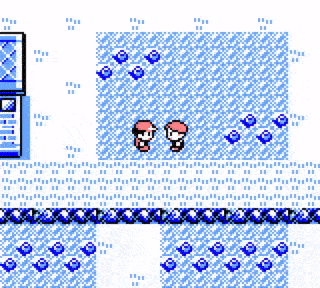
Code
Let's dive into the obfuscated code. I've made an unobfuscated version, where I've given the variables better names and formatted it using clang-format, but have otherwise not changed it.
Let's start at the top.
Opcode Macros
As mentioned above, most instructions can be grouped into one of ~40
categories. To make it easier to group them, I made 10 different macros:
OP4_NX8, OP4_NX16_REL, OP5_FLAG, OP8_NX8_REL, OP7_PTR, OP7_NX8,
OP7_NX8_PTR, OP49_REL, OP56_PTR_REL, OP9_IMM_PTR.
The naming convention I've used is as follows:
OPn: This macro definesninstructions.NXm: Each instruction is spaced out by multiples ofm.PTR: This macro also sets theptr8variable, which points to the address of the 8-bit source register.REL: This macro also sets theopcode_relvariable, which is the offset of the given opcode in its group (e.g.OP4_NX16_RELwill haveopcode_relvalues of 0, 16, 32, or 48). This can be helpful for indexing into a register array.IMM: This macro also defines the "immediate" instruction e.g,ADD A, u8.FLAG: This macro defines an instruction that uses theconditioncodes as well as its unconditional version, e.g.CALL NZ, u16andCALL u16.
Let's take a look at some of the more interesting macros:
First up is OP5_FLAG. This macro defines 4 conditional instructions, as well
as the unconditional version. Here the variable carry is re-purposed to
determine whether the operation should be performed:
#define OP5_FLAG(_, always) \
OP4_NX8(_) \
case always: \
carry = (opcode == always) || \
(F & F_mask[(opcode - _) / 8]) == F_equals[(opcode - _) / 8];The F_mask and F_equals arrays are defined to encode
the condition table above, and F is the flag register:
For example, the condition NZ means to execute the instruction if the Z
flag is not set. The Z flag is bit 7 of the flags register, or 128 in
decimal. So we can tell if Z is not set by calculating (F & 128) == 0.
int F_mask[] = {128, 128, 16, 16},
F_equals[] = {0, 128, 0, 16};Next is OP9_IMM_PTR. This macro defines 9 instructions, one for each entry in
the r8 table above, as well as for the immediate instruction (which is always
at an offset of 70). Each of these instructions operate on an 8-bit operand:
one of the 7 registers (A, B, C, D, E, H, or L), the byte at
address HL, or the immediate value u8.
The read8_pc() function reads the next byte at PC (i.e. the next byte in
the instruction stream). The read8() function can read a byte at any address,
but defaults to reading the byte at HL. And as mentioned above, ptr8 points
to one of the 8-bit registers.
#define OP9_IMM_PTR(_) \
case _ + 6: \
case _ + 70: \
OP7_PTR(_) \
operand = (opcode == _ + 6) ? read8() \
: (opcode == _ + 70) ? read8_pc() \
: *ptr8;Registers
It's convenient to be able to access most registers both as their 16-bit pairs or their 8-bit parts. So all CPU registers are defined in an array, along with their initial values.
These are defined in the order C, B, E, D, L, H, F, A,
SP Low, SP High. This allows us to read a 16-bit register pair directly as
long as the host machine is little-endian. Note that SP is never accessed as an
8-bit register, so it doesn't need to be defined here; this may be a place
where I could save some additional bytes.
The A and F registers are used for many of the instructions directly, so we
create references to them by name.
uint8_t reg8[] = {19, 0, 216, 0, 77, 1, 176, 1, 254, 255},
&F = reg8[6],
&A = reg8[7];The r8 group described above uses the order B, C, D, E, F, H, L, (HL), A.
The reg8_group array matches this, but uses &F instead. This is never
actually used, so it could have been 0 instead to save a byte.
uint8_t *reg8_group[] = {reg8 + 1, reg8,
reg8 + 3, reg8 + 2,
reg8 + 5, reg8 + 4,
&F, &A}There are three r16 groups above, and each are represented here, with reg16
being r16 (group 3). Group 2 is actually meant to be BC, DE, HL+, HL-,
where HL+ and HL- use the current value of HL and then increment or
decrement, respectively. That behavior is not included here, but instead used
directly in the instructions' implementations via the HL_add array.
As with A and F, HL and SP are often used directly, so we've created
references to them by name.
uint16_t PC = 256,
*reg16 = (uint16_t *)reg8,
*reg16_group1[] = {reg16, reg16 + 1, &HL, &SP},
*reg16_group2[] = {reg16, reg16 + 1, &HL, &HL},
&HL = reg16[2], &SP = reg16[4];
int HL_add[] = {0, 0, 1, -1};Finally, there is a helper function for setting CPU flags. The mask parameter
masks out any flags that are supposed to be set by this instruction, then the
Z, N, H, C parameters will set it to their new value. As a size
optimization, the Z flag is negated here. That's because many instructions
set the Z flag if the instruction produces a 0 result, so it's convenient to
do the logical not here rather than all places that call set_flags().
void set_flags(uint8_t mask, int Z, int N, int H, int C) {
F = (F & mask) | (!Z * 128 + N * 64 + H * 32 + C * 16);
}Memory
All the memory for the system is stored in static arrays or memory-mapped regions.
uint8_t *rom0, *rom1, *extram, *extrambank;rom0: a pointer to the first 16KiB bank of ROM (addresses$0000-$3FFF). This is memory-mapped at the beginning of the program.rom1: a pointer to the currently mapped bank of ROM1 (addresses$4000-$7FFF).extram: a pointer to the entire 32KiB of External RAM. This is memory-mapped at the beginning of the program.extrambank: A pointer to the currently mapped 8KiB of External RAM.
uint8_t io[512], video_ram[8192], work_ram[16384];io: the 512 bytes from addresses$FE00-$FFFF; this includes OAM, I/O, and high RAM.video_ram: 8KiB bytes of video RAM.work_ram: 16KiB of work RAM, used by the game for any purpose.
The registers IF, LCDC, LY, and DIV are used enough times that it saves
source code to reference them by name, rather than via the io array:
uint8_t &IF = io[271], &LCDC = io[320], &LY = io[324];
uint16_t &DIV = (uint16_t &)io[259];The frame_buffer is a 160 * 144 = 23040 buffer, with an int for each
pixel. I assume that an int is 4-bytes, so it can store a 32-bit RGBA value.
int frame_buffer[23040];
int palette[] = {-1, -23197, -65536, -16777216, -1, -8092417,
-12961132, -16777216, -1, -23197, -65536, -16777216};The palette values look strange, but they are stored as signed-integers to save in source code size. When written as hexadecimal values, they look more natural. (Note that these values are stored so the red channel is the least-significant byte and the alpha channel is the most-significant byte):
| Palette | Color 0 | Color 1 | Color 2 | Color 3 |
|---|---|---|---|---|
| BGP | 0xffffffff |
0xffffa563 |
0xffff0000 |
0xff000000 |
| OBP0 | 0xffffffff |
0xff8484ff |
0xff3a3a94 |
0xff000000 |
| OBP1 | 0xffffffff |
0xffffa563 |
0xffff0000 |
0xff000000 |
Memory Access
The CPU can only read or write one byte at a time. The mem_access() function
implements both reading and writing to save on source code size. If write == 0 then val is ignored. If write != 0, then the return value is ignored.
First, note that all memory accesses call tick(). This increments the cycle
counter by 4, which is the number of T-states required to do an 8-bit memory
access.
As a size-optimization, both read8() and write8() take HL as the default
address. This requires write8() to be written "backward", with val as the
first parameter and addr as the second.
In mem_access(), the address is shifted right by 12. This extracts the top
nibble of the address, which can then be used to determine which region of
memory was accessed.
void tick() { cycles += 4; }
uint8_t mem_access(uint16_t addr, uint8_t val, int write) {
tick();
switch (addr >> 12) {
...
}
}
uint8_t read8(uint16_t addr = HL) { return mem_access(addr, 0, 0); }
void write8(uint8_t val, uint16_t addr = HL) { mem_access(addr, val, 1); }For cases 2 and 3, the address being accessed is in the range $2000-$3FFF. If
this region is written to, it will remap ROM bank 1 (see the Memory Bank
Controllers section above). The bank number is shifted left by 14, since each
bank is 1 << 14 = 16KiB.
Either way, we fall through to cases 0 and 1 below. For 0 and 1, the address
being accessed is in the range $0000-$1FFF, which is in ROM bank 0.
case 2: case 3:
if (write)
rom1 = rom0 + ((val ? val & 63 : 1) << 14);
case 0: case 1:
return rom0[addr];For cases 4 and 5, the address being accessed is in the range $4000-5FFF. If
the region is written to, it will remap the External RAM bank. Either way, we
fall through to cases 6 and 7 below, which covers the ROM bank 1 region.
case 4: case 5:
if (write && val <= 3)
extrambank = extram + (val << 13);
case 6: case 7:
return rom1[addr & 16383];Cases 8 and 9 are the video RAM region, addresses $8000-$9FFF. On the real
gameboy the video RAM cannot be updated during certain times (e.g. when the PPU
is accessing it), but we assume the game is well-behaved and allow it at all
times.
case 8: case 9:
addr &= 8191;
if (write)
video_ram[addr] = val;
return video_ram[addr];Cases 10 and 11 are in the external RAM region, addresses $A000-$BFFF. On
real gameboy there are ways to disable read and write access to this region,
but again we assume that the game is well-behaved and allow it at all times.
case 10: case 11:
addr &= 8191;
if (write)
extrambank[addr] = val;
return extrambank[addr];Case 15 is the most complex. Here we first test if the address is greater than
or equal to 65024 ($FE00). If so, then we know that we're accessing
somewhere in the io region, which includes OAM, I/O, and High RAM.
If the address is a write to 65350 ($FF46), then the game is requesting a
DMA transfer to OAM. This is an extremely common way for games to copy sprite
data into OAM, since it is much faster than having the CPU do it manually. The
value written to $FF46 is used as the high byte of the source address. So,
for example, if the value is $C1, then 160 bytes will be copied from
$C100-$C19F to OAM.
If the address read from is 65280 ($FF00), then the game is reading the
JOYP register which gives the current joypad state. The value returned
depends on what was previously written to JOYP, either the directions buttons
if bit 4 of JOYP is 0, or the face buttons if bit 5 of JOYP is 0. If
neither is 0, then JOYP returns 255 ($FF).
Finally, if the memory access address is less than 65024, then it must be an
access to work RAM, either the primary address range at $C000-$DFFF, or the
mirror range at $E000-$FDFF. In either case the address is masked and a write
or read is performed.
case 15:
if (addr >= 65024) {
if (write) {
if (addr == 65350)
for (int y = 160; --y >= 0;)
io[y] = mem_access(val * 256 + y, 0, 0);
io[addr & 511] = val;
}
if (addr == 65280) {
if (!(io[256] & 16))
return ~(16 + key_state[SDL_SCANCODE_DOWN] * 8 +
key_state[SDL_SCANCODE_UP] * 4 +
key_state[SDL_SCANCODE_LEFT] * 2 +
key_state[SDL_SCANCODE_RIGHT]);
if (!(io[256] & 32))
return ~(32 + key_state[SDL_SCANCODE_RETURN] * 8 +
key_state[SDL_SCANCODE_TAB] * 4 +
key_state[SDL_SCANCODE_Z] * 2 +
key_state[SDL_SCANCODE_X]);
return 255;
}
return io[addr & 511];
}
case 12 ... 14:
addr &= 16383;
if (write)
work_ram[addr] = val;
return work_ram[addr];A few more functions are used to reduce code size. First read8_pc()
(mentioned above), which reads a byte from the instruction stream.
uint8_t read8_pc() { return read8(PC++); }Next read16(), which reads a 16-bit value from any address, but defaults to
PC. The gameboy CPU is little-endian, so this writes the least-significant
byte first. This function is also used to implement the POP instruction. Note
that addr must be incremented in separate statements to avoid undefined
behavior.
uint16_t read16(uint16_t &addr = PC) {
tmp8 = read8(addr++);
return read8(addr++) * 256 + tmp8;
}Then push(), which pushes a 16-bit value onto the stack. The most-significant
byte is written first, because the value is written as SP is decremented.
Also note that the tick() is called because PUSH always takes an additional
M-cycle.
void push(uint16_t val) {
write8(val >> 8, --SP);
write8(val, --SP);
tick();
}Initialization
The main() function begins by initializing the ROM and External RAM areas:
Since we know that Pokémon Blue is 1MiB, we can directly mmap it. This saves
some space over fopen/fread as long as we use numbers instead of
PROT_READ, etc.
int main() {
rom1 = (rom0 = (uint8_t *)mmap(0, 1048576, PROT_READ, MAP_SHARED,
open("rom.gb", O_RDONLY), 0)) +
32768;
...
}Similarly, we can mmap the External RAM file, though this is even more
convenient since any writes to this region will automatically be written to the
save file.
One slightly annoying quirk is that the file must be truncated to the correct length, or else writes will crash the emulator. This behavior seems to work on Linux, but fails on macOS (see pokegb issue 1):
tmp = open("rom.sav", O_CREAT|O_RDWR, 0666);
ftruncate(tmp, 32768);
extrambank = extram =
(uint8_t *)mmap(0, 32768, PROT_READ | PROT_WRITE, MAP_SHARED, tmp, 0);The LCDC and DIV I/O registers are set to initial values to match binjgb.
It's likely that this isn't actually required, and could be removed to save
some bytes.
LCDC = 145;
DIV = 44032;Next we initialize SDL:
SDL_Init(SDL_INIT_VIDEO);Then create a window at 5x the gameboy resolution, along with a renderer that can draw to it:
SDL_Renderer *renderer = SDL_CreateRenderer(
SDL_CreateWindow("pokegb", 0, 0, 800, 720, SDL_WINDOW_SHOWN), -1,
SDL_RENDERER_PRESENTVSYNC);And create a texture at the gameboy resolution that we will lock and draw to later:
SDL_Texture *texture = SDL_CreateTexture(
renderer,
SDL_PIXELFORMAT_RGBA32,
SDL_TEXTUREACCESS_STREAMING,
160, 144);And finally grab the keyboard state array. Conveniently, this will be automatically updated by SDL whenever we poll for events:
key_state = SDL_GetKeyboardState(0);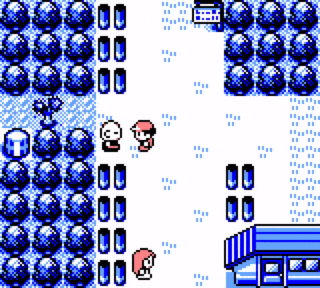
CPU
After initialization, we start a loop that steps the CPU and updates the graphics. There are a few different states that the CPU can be in: running normally, "halted" waiting for an interrupt, and handling an interrupt.
That is all handled at the start of the loop:
while (1) {
prev_cycles = cycles;
if (IME & IF & io[511]) {
IF = halt = IME = 0;
cycles += 8;
carry = 1;
temp16 = 64;
goto CALL;
} else if (halt)
tick();
else
switch (opcode = read8_pc()) {
...
}
...
}First, the the current cycle counter is saved so we know how many cycles to
update the PPU later. Then we check if any bit is set in all of Interrupt
Master Enable flag (IME), Interrupt Request (IF), and Interrupt Enable
(io[511]). Since pokegb only supports the vblank interrupt, then we know that
we only need to check for bit 0, but it's smaller to check for any bit here.
If an interrupt occurs, the CPU is no longer halting, and the IME and IF
flags are cleared. The CPU then performs the equivalent of a CALL to address
$0040 (64) which is the vblank interrupt handler.
If the CPU is halted, then we simply tick the clock and loop until an interrupt occurs.
Otherwise, we read the next byte in the instruction stream and try to execute it.
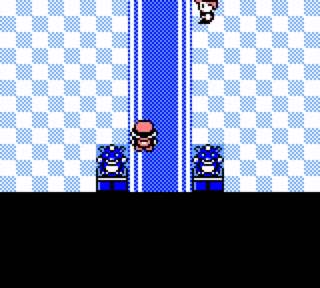
Instructions
This is the real meat of the emulator. As we saw above, there are a lot of
instructions, and most of them are needed to run Pokémon Blue. Let's start with
the simplest instruction, NOP, which does nothing:
case 0: // NOP
break;Off to a good start! Next is LD r16, u16, which copies a 16-bit value from
the instruction stream into a 16-bit register pair. This handles opcodes 1, 17,
33, and 49. Since these opcodes are spaced by multiples of 16, we can shift
right by 4 to index into r16 (group 1):
OP4_NX16_REL(1) // LD r16, u16
*reg16_group1[opcode >> 4] = read16();
break;Next up, LD (r16), A, which writes A into memory at a given address. This
also can optionally increment or decrement HL. Notice that we use
opcode_rel for this; it's not required in this case since opcode / 16 is
equal to opcode_rel / 16. But for other instructions it will be useful:
OP4_NX16_REL(2) // LD (r16), A
write8(A, *reg16_group2[opcode >> 4]);
HL += HL_add[opcode_rel / 16];
break;Then INC r16 and DEC r16, which increment or decrement a register pair.
These take an additional M-cycle, so tick() is called.
OP4_NX16_REL(3) // INC r16
(*reg16_group1[opcode >> 4])++;
tick();
break;
OP4_NX16_REL(11) // DEC r16
(*reg16_group1[opcode >> 4])--;
tick();
break;Likewise there are INC r8 and DEC r8 which increment or decrement an 8-bit
register. Unlike their 16-bit equivalents, these update CPU flags. goto is
used to share some code:
OP7_NX8_PTR(4) // INC r8
tmp8 = ++(*ptr8);
goto INC_FLAGS;
OP7_NX8_PTR(5) // DEC r8
tmp8 = --(*ptr8);
goto DEC_FLAGS;The r8 group also includes (HL), which means to use the byte at the address
HL instead. It is simpler to handle these separately, using read8() and
write8().
These instructions also have the code to handle setting flags. Remember that
the first parameter is the mask. 16 is the value of the carry flag, so this
mask means that the carry flag will be preserved. The other flags are set
according to the rest of the arguments: Z is set if the result is zero, N
is set if the operation was a decrement, and H is set if there was an
overflow to bit 4 of the result.
case 52: // INC (HL)
write8(tmp8 = read8() + 1);
INC_FLAGS:
set_flags(16, tmp8, 0, !(tmp8 & 15), 0);
break;
case 53: // DEC (HL)
write8(tmp8 = read8() - 1);
DEC_FLAGS:
set_flags(16, tmp8, 1, tmp8 % 16 == 15, 0);
break;Next is LD r8, u8, which loads a value from the instruction stream into a
register or (HL).
OP7_NX8_PTR(6) // LD r8, u8
*ptr8 = read8_pc();
break;
case 54: // LD (HL), u8
write8(read8_pc());
break;Next, RLCA and RRCA, which rotate the A register left or right by one
bit. The bit that is rotated out is copied to the carry flag, as well as moved
to the other end.
A += A is used instead of A << 1, and A / 2 is used instead of A >> 1
to reduce code size.
case 7: // RLCA
A += A + (carry = A >> 7);
goto CARRY_FLAG;
case 15: // RRCA
A = (carry = A & 1) * 128 + A / 2;
goto CARRY_FLAG;RLA is similar to RLCA, but it rotates the A register "through" the carry
flag, meaning that it is a 9-bit rotate. Bit 7 of A is moved into the carry
flag, and the carry flag is moved into bit 0 of A.
When the flags are set, the mask is 0, which means that all flags are set: Z
is always 1, N and H are 0, and C is set to carry:
The expression F / 16 % 2 looks odd, but extracts the carry bit from F into
bit 0.
case 23: // RLA
carry = A >> 7;
A += A + F / 16 % 2;
CARRY_FLAG:
set_flags(0, 1, 0, 0, carry);
break;Now onto the JR instructions. They branch the PC to a new location,
relative to where the current PC is, either forward or backward. That's why
tmp8 is cast to an int8_t. The carry variable is used as a condition,
which is automatically set by the OP5_FLAG macro. Notice also that this uses
the comma operator to save a byte of source code.
OP5_FLAG(32, 24) // JR i8 / JR <condition>, i8
tmp8 = read8_pc();
if (carry)
PC += (int8_t)tmp8, tick();
break;Next is a beast of an instruction, Decimal Adjust for Addition (DAA). It's
intended to be used for handling arithmetic on Binary Coded Decimal
(BCD) values.
The basic idea is relatively simple: a two-digit decimal number can be stored
in a byte where each nibble stores one digit. For example, the decimal number
42 can be stored as the hexadecimal number $42 (66). This is useful for
older harware that didn't have a divide instruction, like the gameboy.
DAA is used after addition or subtraction to fix the BCD value. So if we take
the decimal numbers 42 and add 9, we expect to get 51. But if we do this with
BCD values, we'll get $4B instead. Executing DAA after this addition will
adjust $4B to $51 as expected.
The first if determines whether we need to adjust the least-significant
nibble, and the second if determines whether we need to adjust the
most-significant nibble. The adjustment value added to (or subtracted from) A
is either $00, $06, $60, or $66, depending on the values of the H,
C, and N flags, and the current value of the A register.
For our example, $06 will be added to $4B to produce $51.
case 39: // DAA
carry = tmp8 = 0;
if (F & 32 || (!(F & 64) && A % 15 > 9))
tmp8 = 6;
if (F & 16 || (!(F & 64) && A > 153))
tmp8 |= 96, carry = 1;
set_flags(65, A += (F & 64) ? -tmp8 : tmp8, 0, 0, carry);
break;
Now a simpler one, CPL. This instruction performs the ones' complement of
A, which means flipping all of its bits.
case 47: // CPL
A = ~A;
set_flags(129, 1, 1, 1, 0);
break;SCF and CCF set or complement the carry flag. The implementation combines
them to save on space.
case 55: case 63: // SCF / CCF
set_flags(128, 1, 0, 0, opcode == 55 ? 1 : !(F & 16));
break;The LD r8, (HL) and LD (HL), r8 instructions read from or write to memory.
In this case there is an exception to the pattern; normally the r8 group
includes (HL), but there is no LD (HL), (HL) instruction. That instruction
is instead HALT.
OP7_NX8_PTR(70) // LD r8, (HL)
*ptr8 = read8();
break;
OP7_PTR(112) // LD (HL), r8
write8(*ptr8);
break;Speaking of which, here's HALT. On the real gameboy, there are some
complexities with how HALT behaves, but here we merely set the halt
variable to 1.
case 118: // HALT
halt = 1;
break;The LD r8, r8 group covers 49 different instructions, not including (HL).
It has several seemingly redundant instructions, such as LD B, B and LD C, C. Some emulators use these instructions as a breakpoint instead, since they
otherwise have no purpose:
OP49_REL(64) // LD r8, r8
*reg8_group[opcode_rel / 8] = *reg8_group[opcode & 7];
break;Here's one of the trickier set of instructions. There are 4 different
operations handled here: addition (ADD), addition with carry (ADC),
subtraction (SUB), and subtraction with carry (SBC). In other words, each
instruction does the following:
ADD:A = A + operand + 0ADC:A = A + operand + carrySUB:A = A - operand - 0SBC:A = A - operand - carry
They all can be implemented using the same code. In regular mathematics, we can
rewrite subtraction as addition (e.g. 3 - 5 = 3 + -5). We can do the same for
two's complement arithmetic, but instead of negating the operand, we can
complement it (~) and add one, which is equivalent:
ADD:A = A + operand + 0ADC:A = A + operand + carrySUB:A = A + ~operand + 1 - 0SBC:A = A + ~operand + 1 - carry
But since carry is either 0 or 1, we can simplify this to:
ADD:A = A + operand + 0ADC:A = A + operand + carrySUB:A = A + ~operand + 1SBC:A = A + ~operand + ~carry
The only additional complication is how to deal with the flags. The N flag is
simplest, it is 0 for addition and 1 for subtraction. The H flag is set
if there is an overflow into bit 4 of the result. It turns out that we can
correctly calculate this by seeing if the sum of the low nibbles of A,
operand, and carry is greater than 15. For subtraction, we take this
result and flip it, i.e. we only set the H flag if the sum is not greater
than 15. Similarly, the C flag checks for an overflow out of bit 7 of the
result, so we check whether the sum A + operand + carry is greater than 255.
OP9_IMM_PTR(128) // ADD A, r8 / ADD A, (HL) / ADD A, u8
neg = carry = 0;
goto ALU;
OP9_IMM_PTR(136) // ADC A, r8 / ADC A, (HL) / ADC A, u8
neg = 0;
carry = F / 16 % 2;
goto ALU;
OP9_IMM_PTR(144) // SUB A, r8 / SUB A, (HL) / SUB A, u8
carry = 1;
goto SUBTRACT;
OP9_IMM_PTR(152) // SBC A, r8 / SBC A, (HL) / SBC A, u8
carry = !(F / 16 % 2);
SUBTRACT:
neg = 1;
operand = ~operand;
ALU:
set_flags(0, tmp8 = A + operand + carry, neg,
(A % 16 + operand % 16 + carry > 15) ^ neg,
(A + operand + carry > 255) ^ neg);
A = tmp8;
break;Next are the common bitwise operations, AND, OR, and XOR. They are
relatively straightforward since c++ has built-in operators for them:
OP9_IMM_PTR(160) // AND A, r8 / AND A, (HL) / AND A, u8
set_flags(0, A &= operand, 0, 1, 0);
break;
OP9_IMM_PTR(168) // XOR A, r8 / XOR A, (HL) / XOR A, u8
set_flags(0, A ^= operand, 0, 0, 0);
break;
OP9_IMM_PTR(176) // OR A, r8 / OR A, (HL) / OR A, u8
set_flags(0, A |= operand, 0, 0, 0);
break;Next up is the collection of CP instructions. They have the same behavior as
SUB, except they don't modify A, only the CPU flags:
OP9_IMM_PTR(184) // CP A, r8 / CP A, (HL) / CP A, u8
set_flags(0, A != operand, 1, A % 16 < operand % 16, A < operand);
break;Now we get to the set of RET instructions. They return from a function call
by popping the return address off of the stack. Like the JR instructions
above, they come in "conditional" and "unconditional" flavors. The OP5_FLAG
macro sets carry to the result of the condition. But there's also RETI,
which is the same as RET followed by EI (enable interrupts).
case 217: // RETI
carry = IME = 1;
goto RET;
OP5_FLAG(192, 201) // RET / RET <condition>
RET:
tick();
if (carry)
PC = read16(SP);
break;Then onto PUSH and POP instructions. These write to or read from the stack,
and then move the stack pointer accordingly. They don't have to be used for
stack access, however. Pokémon Blue actually uses them to decode some graphics
during vblank, since POP is a fast way to read 16 bits into a register pair.
OP4_NX16_REL(193) // POP r16
reg16[opcode_rel >> 4] = read16(SP);
break;
OP4_NX16_REL(197) // PUSH r16
push(reg16[opcode_rel >> 4]);
break;The JP instructions is similar to the JR instructions, except that the jump
is absolute instead of relative.
OP5_FLAG(194, 195) // JP u16 / JP <condition>, u16
temp16 = read16();
if (carry)
PC = temp16, tick();
break;The CALL instructions are similar to the JP instructions, but the also push
the old PC to the stack first:
OP5_FLAG(196, 205) // CALL u16 / CALL <condition>, u16
temp16 = read16();
CALL:
if (carry)
push(PC), PC = temp16;
break;The gameboy also has some instructions to make it easier to access the top 256
bytes of the address space ($FF00-$FFFF). The byte offset is either read from
the instruction stream as ($FF00 + u8) or from the C register as ($FF00 + C).
The LD A, (u16) instruction is also implemented here, which reads an address
from memory, then reads that byte into the A register. Its implementation is
combined with LD A, ($FF00 + u8) to save space.
case 224: case 226: // LD ($FF00 + u8), A / LD ($FF00 + C), A
write8(A, 65280 + (opcode == 224 ? read8_pc() : *reg8));
break;
case 240: case 250: // LD A, ($FF00 + u8) / LD A, (u16)
A = read8(opcode == 240 ? 65280 | read8_pc() : read16());
break;The counterpart to LD A, (u16) is LD (u16), A, which reads an address from
the instruction stream, then writes the value in the A register to that
address. This probably could have been combined with case 224 and 226 above
to save space.
case 234: // LD (u16), A
write8(A, read16());
break;All of the other jump instructions we've seen so far take an immediate offset
or address, but JP HL is used when you want to jump to an arbitrary address,
for example, to implement a jump table.
case 233: // JP HL
PC = HL;
break;The Interrupt Master Enable (IME) flag can be modified with the DI and EI
instructions, either disabling or enabling the flag.
case 243: case 251: // DI / EI
IME = opcode != 243;
break;Finally, there are two instructions that copy between HP and SP. The LD HL, SP + i8 adds a signed value to SP and stores it in the HL register. On
the other hand, LD SP, HL just copies the HL register directly into SP.
case 248: // LD HL, SP + i8
tmp8 = read8_pc();
set_flags(0, 1, 0, (uint8_t)SP + tmp8 > 255, SP % 16 + tmp8 % 16 > 15);
HL = SP + (int8_t)tmp8;
tick();
break;
case 249: // LD SP, HL
SP = HL;
tick();
break;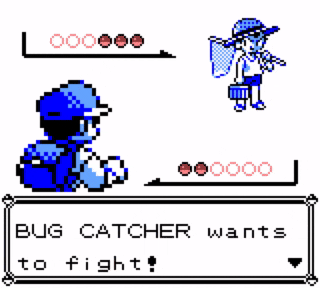
$CB Instructions
The $CB instruction is an instruction prefix. All $CB instructions are two
bytes, and the second byte determines which operation it is (see opcode group 3
above).
First off are RLC and RRC, which are similar to RLCA and RRCA above but
can be used for any register (as well as HL) Interestingly, the RRC (HL)
instruction is also used by Pokémon Blue, but RLC (HL) doesn't seem to be. It
works the same as RRC r8, but operates on the memory at (HL):
OP7_PTR(0) // RLC r8
*ptr8 += *ptr8 + (carry = *ptr8 / 128 % 2);
goto CARRY_ZERO_FLAGS_PTR;
OP7_PTR(8) // RRC r8
*ptr8 = (carry = *ptr8 & 1) * 128 + *ptr8 / 2;
goto CARRY_ZERO_FLAGS_PTR;
case 14: // RRC (HL)
tmp8 = read8();
carry = tmp8 & 1;
write8(tmp8 = carry * 128 + tmp8 / 2);
goto CARRY_ZERO_FLAGS_TMP;Next are RL and RR. Like RLA and RRA above, these rotate "through" the
carry flag for a 9-bit rotate, but they can be used for any register.
OP7_PTR(16) // RL r8
carry = *ptr8 >> 7;
*ptr8 = *ptr8 * 2 + F / 16 % 2;
goto CARRY_ZERO_FLAGS_PTR;
OP7_PTR(24) // RR r8
carry = *ptr8 & 1;
*ptr8 = *ptr8 / 2 + (F * 8 & 128);
goto CARRY_ZERO_FLAGS_PTR;Now Shift Left Arithmetic (SLA) and Shift Right Arithmetic (SRA).
"Arithmetic" means that SRA behaves like a signed divide by 2. In two's
complement, that means that the most-significant bit (i.e. the sign bit) is not
changed. For example, performing SRA on $43 (67 in decimal, 01000011 in
binary) results in $21 (33 in decimal, 00100001 in binary). On the other
hand, performing SRA on $F0 (-16 in decimal, 11110000 in binary)
results in $F8 (-8 in decimal, 11111000 in binary).
OP7_PTR(32) // SLA r8
carry = *ptr8 / 128 % 2;
*ptr8 *= 2;
goto CARRY_ZERO_FLAGS_PTR;
OP7_PTR(40) // SRA r8
carry = *ptr8 & 1;
*ptr8 = (int8_t)*ptr8 >> 1;
goto CARRY_ZERO_FLAGS_PTR;On the other hand, Shift Right Logical (SRL) fills 0 into the
most-significant bit after a shift. So for example, performing SRL on $F0
(240 in decimal, 11110000 in binary) results in $78 (120 in decimal,
01111000 in binary).
OP7_PTR(56) // SRL r8
carry = *ptr8 & 1;
*ptr8 /= 2;
CARRY_ZERO_FLAGS_PTR:
set_flags(0, *ptr8, 0, 0, carry);
break;The SWAP instructions swap the low and high nibble of the byte. For example,
SWAP on $A3 results in $3A.
OP7_PTR(48) // SWAP r8
set_flags(0, *ptr8 = *ptr8 * 16 + *ptr8 / 16, 0, 0, 0);
break;
case 54: // SWAP (HL)
tmp8 = read8();
carry = 0;
write8(tmp8 = tmp8 * 16 + tmp8 / 16);
CARRY_ZERO_FLAGS_TMP:
set_flags(0, tmp8, 0, 0, carry);
break;The BIT instructions check whether a given bit is set, and set the Z flag
accordingly. The bit to check is encoded in the opcode itself, so we can use
opcode_rel / 8 to extract it:
OP8_NX8_REL(70) // BIT bit, r8
tmp8 = read8();
goto BIT_FLAGS;
OP56_PTR_REL(64) // BIT bit, (HL)
tmp8 = *ptr8;
BIT_FLAGS:
set_flags(16, tmp8 & (1 << opcode_rel / 8), 0, 1, 0);
break;The RES instructions reset (i.e. clear) a given bit in an 8-bit register or
(HL). Again, the bit to clear is encoded in the opcode.
OP8_NX8_REL(134) // RES bit, (HL)
write8(read8() & ~(1 << opcode_rel / 8));
break;
OP56_PTR_REL(128) // RES bit, r8
*ptr8 &= ~(1 << opcode_rel / 8);
break;And finally, the SET instructions set a given bit in an 8-bit register or
(HL).
OP8_NX8_REL(198) // SET bit, (HL)
write8(read8() | 1 << opcode_rel / 8);
break;
OP56_PTR_REL(192) // SET bit, r8
*ptr8 |= 1 << opcode_rel / 8;
break;With that, we've completed the CPU implementation, in 1955 bytes (after removing all unnecessary whitespace).
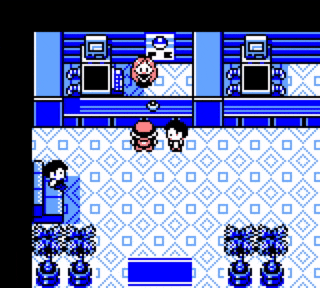
Graphics
Now that we've executed the CPU, we want the PPU to catch up. The current CPU
cycle count is in cycles, and the cycle count before executing the
instruction is in prev_cycles. So we can update the PPU by cycles - prev_cycles T-states.
The DIV I/O register counts the number of T-states as well, but only stores
the high byte of this value at address $FF04. Fortunately $FF03 is left
unused, so we can treat DIV as a 16-bit value starting at $FF03 instead,
and increment it directly:
for (DIV += cycles - prev_cycles; prev_cycles++ != cycles;)
...First off, we only want to draw the screen if the LCD is enabled (see LCDC
bit 7). So we check for that, and otherwise reset the current PPU dot and the
current scanline counter to zero (since it means that the screen is off):
if (LCDC & 128) {
...
} else
LY = ppu_dot = 0;Next we want to trigger a vblank interrupt when the screen is finished
rendering. This happens after the 143rd line finishes, so we check whether the
current "dot" was 0, and whether the current scanline is 144, and set the
interrupt request to 1. This could have been just IF=1, since we don't
support any other interrupts:
if (++ppu_dot == 1 && LY == 144)
IF |= 1;After that is the fun bit, actually drawing a scanline! Since we're keeping things simple, we only render a scanline when it finishes, at dot 456. It is possible on the real gameboy to modify PPU settings during the scanline, but those don't happen in Pokémon Blue.
After rendering the line, we increment LY and reset ppu_dot back to 0.
if (ppu_dot == 456) {
...
LY = (LY + 1) % 154;
ppu_dot = 0;
}If the current scanline is less than 144, we draw it. This includes rendering
the background and window layers, and any sprites that are on this line. We
loop over every x-coordinate as tmp:
if (LY < 144)
for (tmp = 160; --tmp >= 0;) {
...
}First we want to determine if we're drawing the window layer or the background
layer. Like everything else, the real logic to determine this is somewhat
complex, but we can do a simpler version. If the window is enabled, and the
current pixel we're drawing (tmp, LY) is greater than the upper-left
coordinate of the window (WX - 7, WY), then we are drawing the window. Recall
from above that WY is io[330] and WX is io[331]:
uint8_t is_window =
LCDC & 32 &&
LY >= io[330] &&
tmp >= io[331] - 7;Now we want to find out the pixel offset of the current pixel, either into the
background map or the window map. If this pixel is displaying the background,
then we offset by the background scroll registers (SCX, SCY). If instead this
pixel is displaying the window, then we offset by the window's upper left
corner (WX - 7, WY). Again, note that SCX is io[323] and SCY is
io[322]:
uint8_t x_offset = is_window ? tmp - io[331] + 7 : tmp + io[323],
y_offset = is_window ? LY - io[330] : LY + io[322];Now that we know the pixel offset, we can determine which tile is being drawn.
The background and window maps start at either address $9800 or $9C00,
depending on the settings in LCDC. Since we're reading from video RAM
directly (rather than through the read8() function), we want to use the
offset into video RAM instead, $1800 or $1C00. This can be rewritten as $6 << 10 and $7 << 10.
The window map is at $1C00 if LCDC bit 6 is set (== 64), and the
background map is at $1C00 if LCDC bit 3 is set (== 8). So we can
determine the base map address by checking the correct bit, depending on
is_window.
Finally, the tile offset within the map can be found by taking the pixel offset and dividing by 8, since there are 8 pixels per tile in both dimensions. The map is 32x32 tiles, and each tile is one byte, so multiplying the y tile offset by 32 gives the final expression.
We also set the palette_index to 0 by default (which means to use BGP).
uint16_t tile =
video_ram[((LCDC & (is_window ? 64 : 8) ? 7 : 6) << 10) +
y_offset / 8 * 32 + x_offset / 8],
palette_index = 0;Now that we know which tile is being rendered, we have to read the pixel data
for that tile. The starting address of the tile data is either $8000 or
$8800. But as mentioned above, if the starting address is $8800, then
tile 0 is actually at address $9000, and then the tile indexes wrap
around back to $8800 at tile index 128. LCDC bit 4 (== 16) determines
this behavior.
We can get the pixel row of the tile to draw with the expression y_offset % 8. Each row is 2 bytes (since it has two bitplanes) and each tile is 16
bytes:
uint8_t *tile_data =
&video_ram[(LCDC & 16 ? tile : 256 + (int8_t)tile) * 16 +
y_offset % 8 * 2];This gives us the low byte of this row in tile_data[0] and the high byte in
tile_data[1]. x_offset & 7 will give us the offset of the current pixel in
this tile's row. However, you may have noticed above that a tile's row has the
leftmost pixel as the most-significant bit. So, for example, if we are at pixel
offset 0, we want to use bit 7 of the row. This means that the amount to
shift right is actually 7 - x_offset, which is the same as x_offset ^ 7.
x_offset = (x_offset ^ 7) & 7;
uint8_t color =
(tile_data[1] >> x_offset) % 2 * 2 +
(*tile_data >> x_offset) % 2;Let's say we're drawing the fifth pixel of the second row of Ash's pokéball:
| Byte | 7 | 6 | 5 | 4 | 3 | 2 | 1 | 0 | ||||||||
|---|---|---|---|---|---|---|---|---|---|---|---|---|---|---|---|---|
| Low | 0 | 0 | 1 | 0 | 1 | 0 | 1 | 0 | ||||||||
| High | 0 | 0 | 1 | 1 | 0 | 0 | 1 | 0 |
Then x_offset is 3, so when we shift right by 3, we get:
| Byte | 7 | 6 | 5 | 4 | 3 | 2 | 1 | 0 | ||||||||
|---|---|---|---|---|---|---|---|---|---|---|---|---|---|---|---|---|
| Low | 0 | 0 | 0 | 0 | 0 | 1 | 0 | 1 | ||||||||
| High | 0 | 0 | 0 | 0 | 0 | 1 | 1 | 0 |
Then we perform % 2:
| Byte | 7 | 6 | 5 | 4 | 3 | 2 | 1 | 0 | ||||||||
|---|---|---|---|---|---|---|---|---|---|---|---|---|---|---|---|---|
| Low | 0 | 0 | 0 | 0 | 0 | 0 | 0 | 1 | ||||||||
| High | 0 | 0 | 0 | 0 | 0 | 0 | 0 | 0 |
And then we shift the high byte left by 1, and add the bytes together:
| Byte | 7 | 6 | 5 | 4 | 3 | 2 | 1 | 0 | ||||||||
|---|---|---|---|---|---|---|---|---|---|---|---|---|---|---|---|---|
| Both | 0 | 0 | 0 | 0 | 0 | 0 | 1 | 0 |
This gives us a final color of 2.
After we've calculated the background or window pixel color, we may have to
draw a sprite on top of it. Sprites can be enabled or disabled with bit 1 of
LCDC:
if (LCDC & 2)
...OAM has enough space for 40 sprites, each one requiring 4 bytes. On a real
gameboy only 10 sprites can be drawn per scanline, but we'll ignore that
limit. OAM starts at the beginning of io (address $FE00-$FE9F).
for (uint8_t *sprite = io; sprite < io + 160; sprite += 4) {
...
}The sprite's coordinate is (sprite[1] - 8, sprite[0] - 16). Similar to the
background tile, we can find which row and column of the sprite tile by
subtracting the current pixel's coordinate from the sprite's. The sprite's tile
is drawn if the x- and y-offset are both less than 8:
uint8_t sprite_x = tmp - sprite[1] + 8,
sprite_y = LY - *sprite + 16;
if (sprite_x < 8 && sprite_y < 8) {
...
}As with the background tile, we want to xor the x-offset with 7 so the
most-significant bit is also the leftmost bit. However, a sprite can also be
flipped horizontally if bit 5 of sprite[3] is set. In that case we can
leave the x-offset as it is by xor'ing it with 0:
sprite_x ^= sprite[3] & 32 ? 0 : 7;Again, like background tiles, we want to fetch the tile data row for this
sprite. The sprite's tile is in sprite[2]. The sprite can also be flipped
vertically, so we xor the sprite's y-offset with 7 if bit 6 of sprite[3]
is set.
tile_data =
&video_ram[sprite[2] * 16 +
(sprite_y ^ (sprite[3] & 64 ? 7 : 0)) * 2];We can then extract the color of the sprite's pixel:
uint8_t sprite_color =
(tile_data[1] >> sprite_x) % 2 * 2 +
(*tile_data >> sprite_x) % 2;A sprite's pixel is only drawn if the sprite's pixel is non-transparent. In addition, the background pixel also must be transparent or the sprite must have priority over the background for the sprite's pixel to be drawn. In other words, if the background pixel is non-transparent and the sprite doesn't have priority, then the sprite's pixel will not be drawn.
The sprite priority is bit 7 of sprite[3]; if it is 1, then the sprite is
drawn behind the background.
The sprite can use one of two palettes, OBP0 and OBP1. If bit 3 of
sprite[3] is 1, then palette OBP1 is used. We want palette_index to be
1 for OBP0 and 2 for OBP1, so we add one to the value. !! is a little
trick to convert a non-zero value to 1:
if (!((sprite[3] & 128) && color) && sprite_color) {
color = sprite_color;
palette_index += 1 + !!(sprite[3] & 8);
break;
}Now that we know the color and palette_index, we can look it up in the
palette to find the actual RGBA color to draw. Each palette is a single
byte, stored like this:
| Name | Address | io offset |
7 | 6 | 5 | 4 | 3 | 2 | 1 | 0 | ||||||||
|---|---|---|---|---|---|---|---|---|---|---|---|---|---|---|---|---|---|---|
| BGP | $FF47 | 327 | color 3 | color 2 | color 1 | color 0 | ||||||||||||
| OBP0 | $FF48 | 328 | color 3 | color 2 | color 1 | color 0 | ||||||||||||
| OBP1 | $FF49 | 329 | color 3 | color 2 | color 1 | color 0 | ||||||||||||
Adding 327 to palette_index gives us the offset in io for the palette. We
can then shift the palette byte to the right by 2 * color to isolate the
palette entry we want.
We'll write the final RGBA color into the frame buffer at the current pixel's
x- and y-coordinate, (tmp, LY).
frame_buffer[LY * 160 + tmp] =
palette[(io[327 + palette_index] >> (2 * color)) % 4 +
palette_index * 4];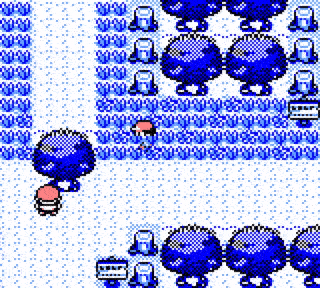
Rendering with SDL
Once we've finished drawing all the lines, we can finally draw the framebuffer
to the window! First we have to lock the texture that we created before, so we
have access to its pixels. The tmp parameter stores the pitch of the texture,
i.e. the width of a row of the texture in bytes, which may include extra
padding.
void *pixels;
SDL_LockTexture(texture, 0, &pixels, &tmp);For each row of the frame buffer, we copy it into the texture. The total number
of bytes copied per row is 160 * 4 == 640, since an RGBA pixel is 4
bytes:
for (tmp2 = 144; --tmp2 >= 0;)
memcpy((uint8_t *)pixels + tmp2 * tmp, frame_buffer + tmp2 * 160,
640);Then we unlock the texture, render it to the window's back buffer, and then present it to the screen:
SDL_UnlockTexture(texture);
SDL_RenderCopy(renderer, texture, 0, 0);
SDL_RenderPresent(renderer);As the very final step, we poll for events, checking to see if the user quit.
This also updates key_state, so we can read from it directly.
SDL_Event event;
while (SDL_PollEvent(&event))
if (event.type == SDL_QUIT)
return 0;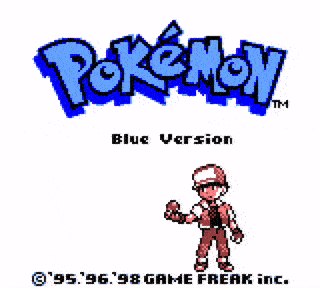
Formatting the Code
Before I sent the tweet, I wanted to make the code look cool. I remember looking at some examples from the IOCCC and thought I'd take a chance at formatting the code into a picture. See, for example, Don Yang's winning entry from the 2020 competition:
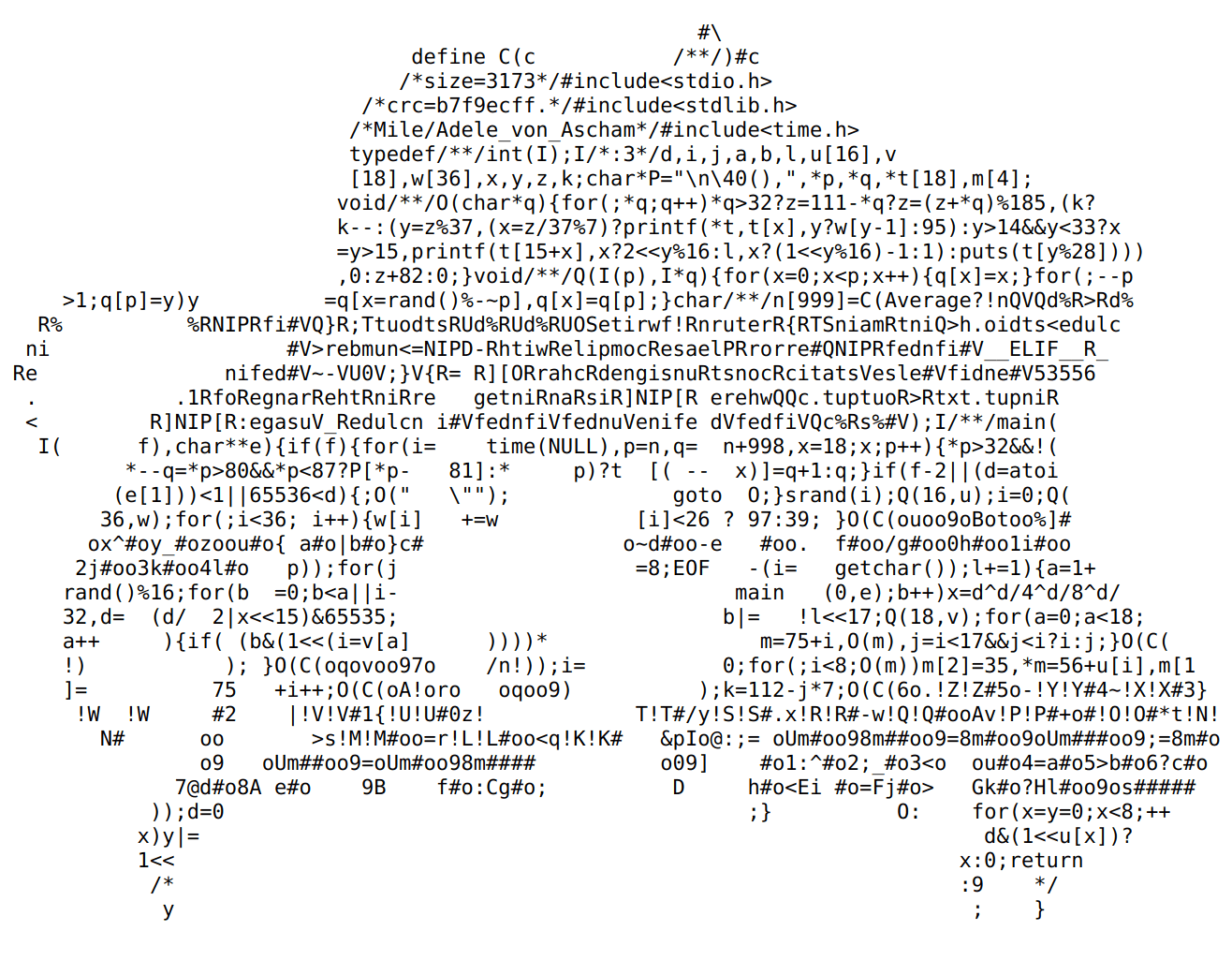
To start, I took the source code I had, and renamed all the variables to single
letter names, where possible. I then removed all whitespace to see how many
characters I was using, which was 4150 bytes, not including the #include and
#define lines.
My first thought was to use the Pokemon logo itself. I tried to make a good 1 bit-per-pixel version, but it ended up looking like garbage when I tried to fit the source code to it:

My next thought was to use a single pokéball. I used the awesome Desmos online calculator to try to figure out how big each circle should be interactively:
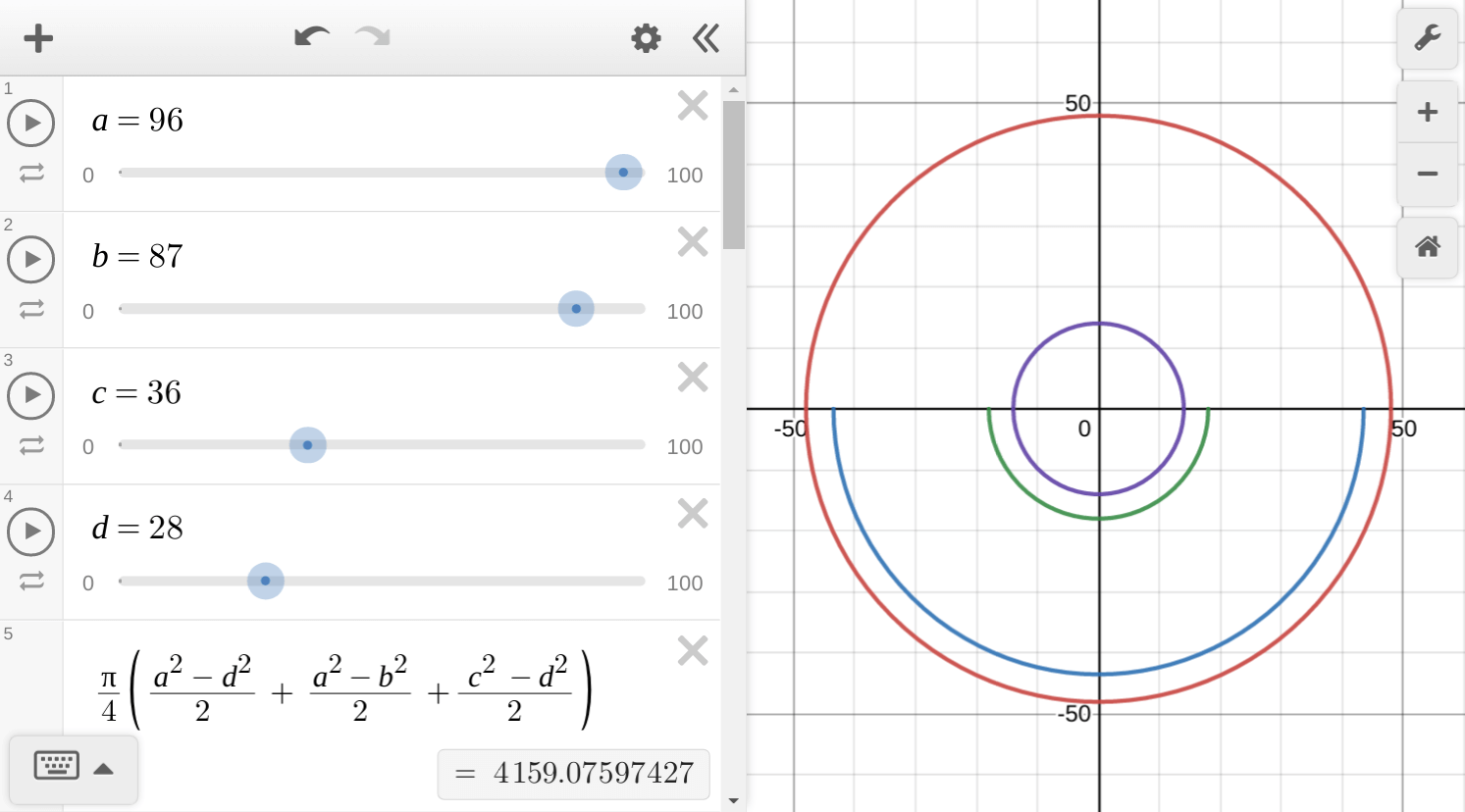
This looks pretty good, but it's a very large pokéball with a diameter of 96. I realized that three pokéballs side-by-side would probably work better, giving a width of 150 and a height of 50:
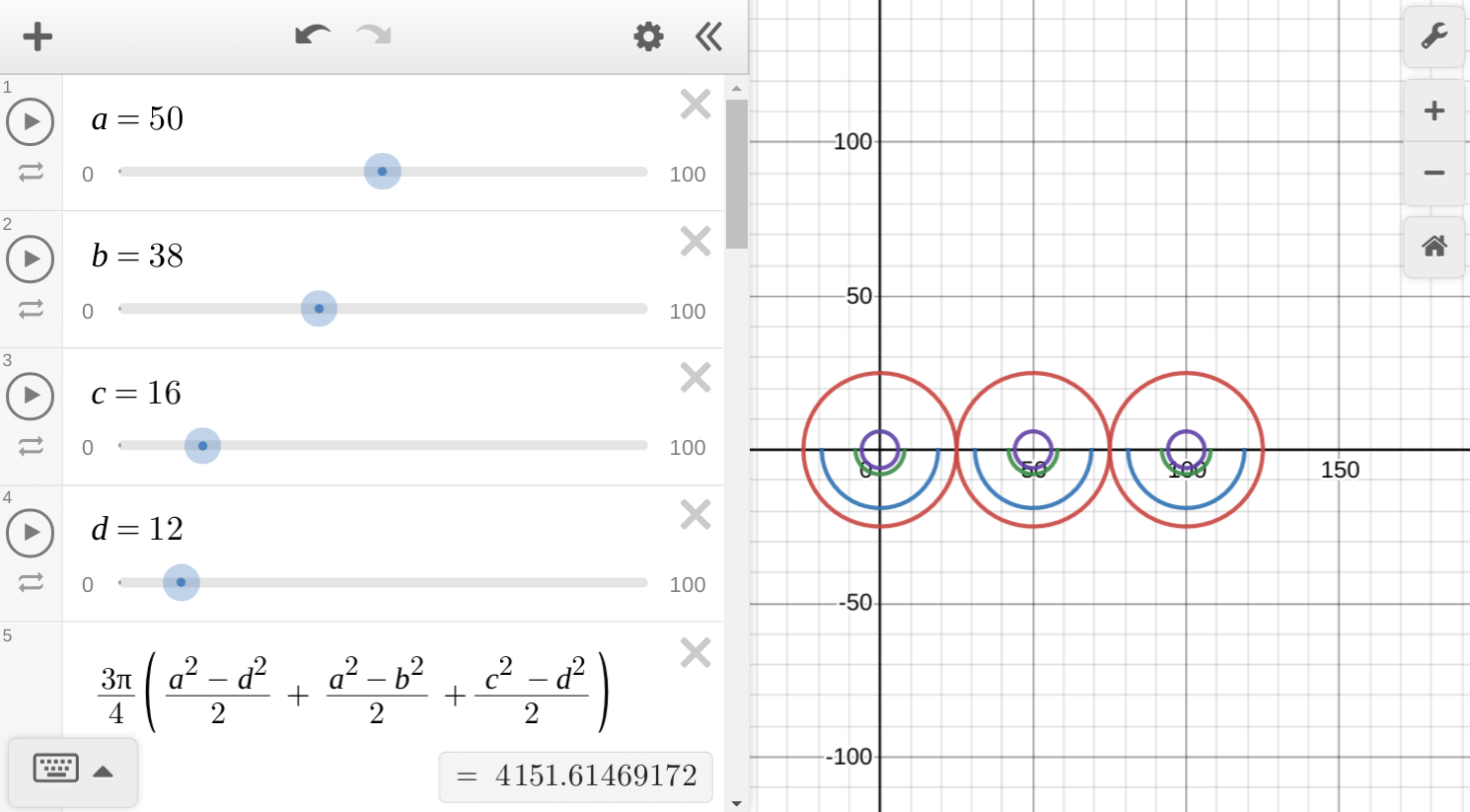
I then recreated as a 150x50 pixel image so that I could convert it to text and use it as a guide for my source code layout:

The result ends up stretched vertically, since most fonts are taller than they are wide, but I still think it looks good! Maybe next time I'll try to take that into account.
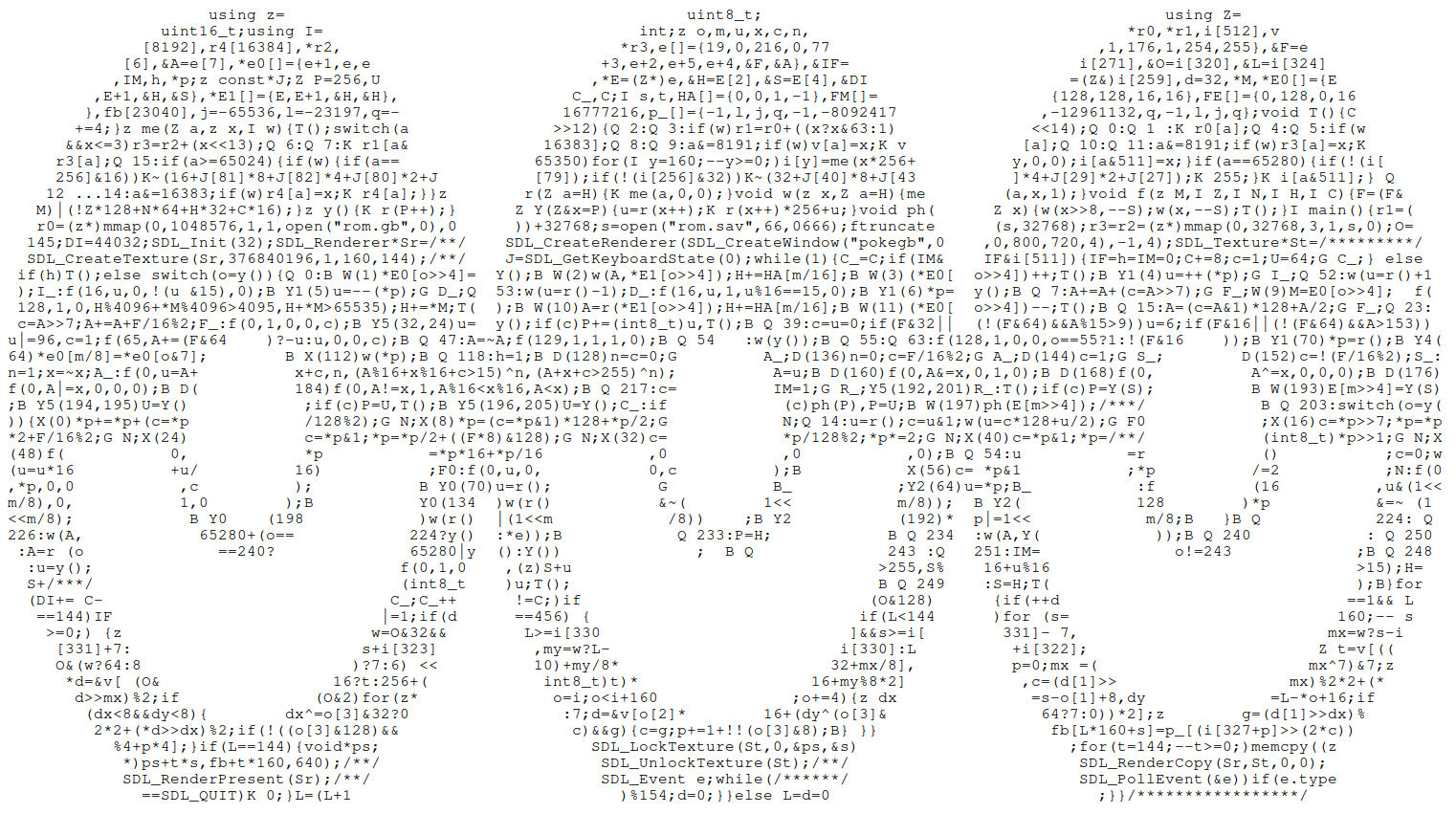
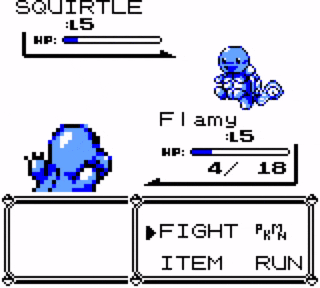
Conclusion
I had a lot of fun making pokegb, and I hope you enjoyed reading about it! If I left anything out or made any mistakes, feel free to send me a message on twitter @binjimint. Thanks to everyone on the emudev discord and the gbdev discord for making such a great community. Cheers!
